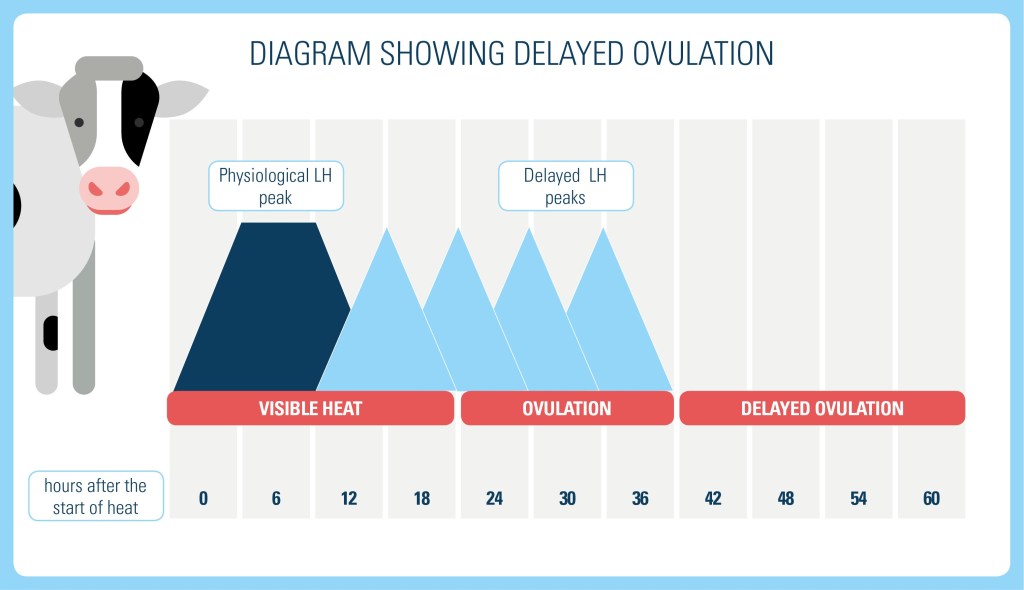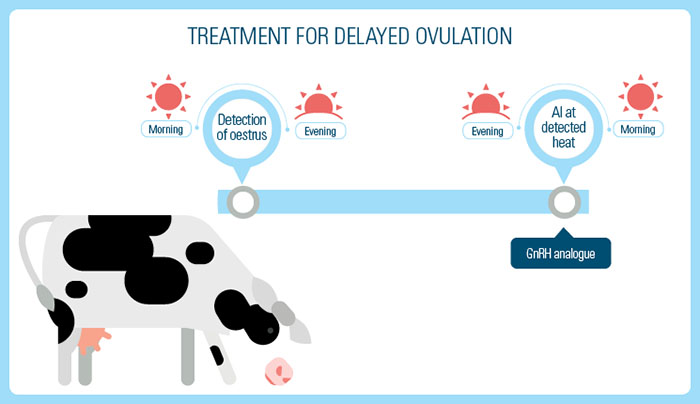

Delayed Ovulation
Ovulation normally takes place approximately 26-28 hours after the preovulatory LH surge or 15-18 hours after external signs of estrus have ceased. A delay in or an inadequate preovulatory LH peak causes delayed ovulation.
Delayed ovulation in cows following estrus minimizes the chances of successful fertilization, and it is diagnosed with increasing frequency in high-yielding dairy cows1.

Ovarian cysts prevent normal ovulation and expression of heat. The clinical signs associated with cysts are the same as missed heats and anestrus—cows that should be seen in heat are not.
Ovarian cysts are more common than true anestrus2, and treated cows with ovarian cysts often have similar fertility to their normal herd mates rather than markedly reduced, as is the case with true anestrus. Delayed ovulation is usually diagnosed when other causes of infertility have been excluded.
- Compromised luteal function due to metabolic deficiencies and very high metabolism:
- Metabolic disorders such as subclinical ketosis and acidosis
- Vitamin A and/or E deficiency
- The effects of high ambient temperature (heat stress)
Often suggested as a cause of repeat breeders: cows cycling regularly but not getting pregnant.
Poor conception rates accompanied by prolonged estrus may indicate that delayed ovulation takes place or that the follicle fails to ovulate.
Poor fertility is associated with delayed ovulation because of:
- Aging of the oocyte within the follicle
- Sperm aging
- Changes in the oviduct environment
- Negative energy balance
- Heat stress
- Infections such as BVD and IBR
- Subluteal levels of progesterone (treatment with progesterone/progestagen releasing devices, inadequate luteal function)

Depending on the size and maturity of the dominant follicle, ovulation usually occurs within 24 hours after GnRH injection, which is similar to the time from onset of estrus until ovulation.
It is best to use GnRH drugs for cattle at the time of AI or up to six hours beforehand due to:
- The chronological relationship between endogenous LH release
- The duration of heat and ovulation
- The survival time of sperm and oocyte
In practice, however, GnRH is usually administered at the same time as AI with very satisfactory results.
Several studies3 have shown a significant increase in the chance of pregnancy in cows treated with:
- GnRH analogue at the first postpartum insemination
- At second service after calving
- In repeat breeder cows treated with GnRH at the time of insemination
Repeat breeder cows responded better to the treatment than the other groups, which supports a hypothesis that a proportion of repeat breeding cows had previously failed to conceive because of a failure in the timing or magnitude of GnRH, LH or FSH surge at estrus.
- Bloch, A., Folman, Y., Kaim, M., Roth, Z., Braw-Tal, R., Wolfenson, D. 2006. Endocrine alterations associated with extended time interval between estrus and ovulation in high-yield dairy cows. J Dairy Sci;89(12):4694-702.
- Laven, R. Fertility in Dairy Herds- Identifying and Treating the Abnormally Cycling Cow. NADIS Animal Health Skills. www.nadis.org.uk.
- Morgan, W.F., Lean, I.J. 1993. Gonadotrophin-releasing hormone treatment in cattle: a meta-analysis of the effects on conception at the time of insemination. Aust Vet J;70(6):205-9.

